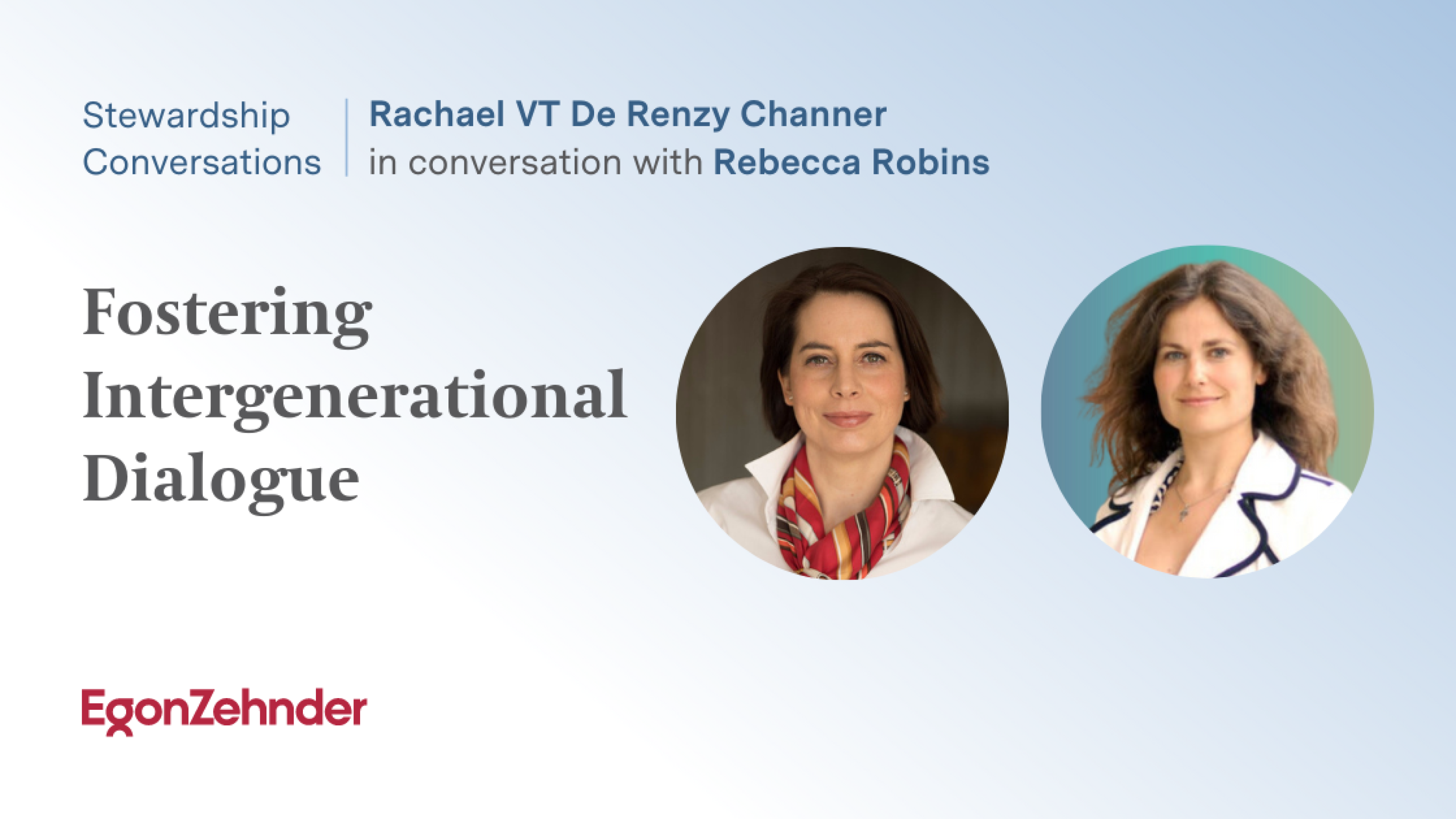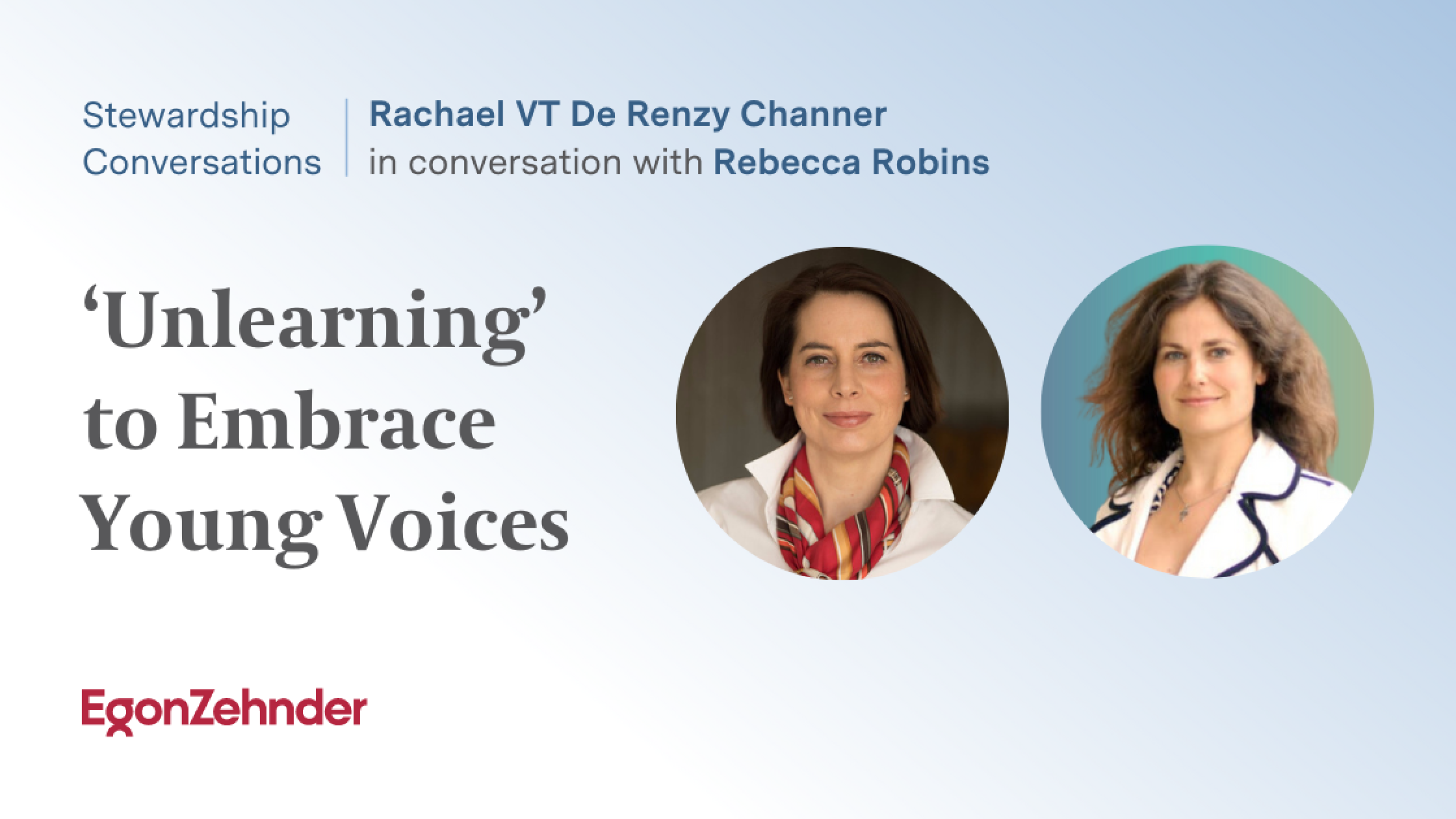Creating environments where younger voices contribute to shaping the future of an organization is an idea that just makes sense. Rebecca Robins, Founder and CEO, Board Trustee, EY Foundation and author, has passionately championed this concept, advancing the purpose of involving younger generations with boardroom conversations and nurturing their potential. Her new book, “Five Generations at Work: How We Win Together, For Good,” was just released in September. It explores how to maximize the dynamics of our generational diversity to create more collaborative, competitive and sustainable organizations.
In this installment of Stewardship Conversations, Robins discusses how organizations can incorporate otherwise "unheard" voices into their board discussions. This approach aligns with Egon Zehnder's research, which emphasizes that bringing diverse voices and a varied mix of individuals to challenge the status quo is essential for boards aiming to address the challenges and opportunities of ESG. Robins delves into her mission of empowering younger generations in the age of AI and outlines strategies companies can adopt to create their own next-generation boards or committees.
Read on for the highlights:
What sparked your interest in sustainability?
Early on in my career, I gained an insight into and understanding of a wider sense of responsibility in business, working across sectors, with leading global brands, family businesses and non-profits. Some of these businesses have sustained across centuries, with their pursuit of long-term excellence, relevance and sustainability. The sense that we are guardians of brands and businesses, has always stayed with me and it continues to gain wider significance in terms of our mandate to act more responsibly and collaboratively in business and society.
How do you define your purpose?
During the financial crisis, futurist Gerd Leonhard said: “Exponential technology will need exponential humanity.” That stuck with me, the sense of what it means to be human—both in terms of leadership, as an individual, and in business. My purpose is to transform the multigenerational workplace in the age of AI. As Einstein predicted: “A quantum leap in technology” will need “a quantum leap in human relations.”
You have been involved in creating next generation boards. Can you share how that started?
The convergence of three experiences ignited my mission to translate ‘what we say’ around the importance of DEI commitments, into ‘what we do’ – as next generation boards are practical and replicable solutions applicable to organizations of all sizes:
- First, I was entrusted with leading and growing a global center for excellence in professional development. Working across generations within organizations ignited my passion and mission for how we look at better connecting our purpose and our culture into how we truly value the very lifeblood of our organizations – our people.
-
Secondly, my work with leading brands reinforced how we can better align employee experience with consumer experience. -
And thirdly, my involvement in boards, including as a Trustee of the EY Foundation, and Chair of the Nomination Committee, reinforced my commitment to rethinking career pathways and board talent pipelines.
Why do we not see more next generation boards?
- Awareness: Next generation boards have not been as widely prevalent as they have been, perhaps, in the civil society sector. Commitments such as Gucci's ‘Shadow Comex’ in 2016 helped raise awareness in how vocal the then CEO was about connecting it into their culture of purpose and business transformation strategy.
-
Purpose: Fundamentally, if you are considering setting up a next generation board, it begins with the ‘why’ and the purpose of a next generation board in your organization. The beauty of these platforms is that there is not one solution, there are many, as evidenced by examples in Five Generations at Work.
This is about bridging awareness gaps and adapting corporate structures to better engage and integrate the next generation into strategic decision-making processes.
How would you select a ‘next generation’ board?
Here are a couple of considerations:
- Build Awareness and Engagement: Before launching, invest time in raising awareness and engaging stakeholders. This ensures broad interest and participation, avoiding the board becoming an exclusive club.
-
Open Application Approach: Instead of relying solely on nominations, which often perpetuate the selection of familiar faces, opt for an open application process. Clearly define criteria and encourage diverse voices to apply, fostering inclusivity and fresh perspectives. (Editor’s note: For a deeper understanding of intentional inclusivity in hiring processes, please read Egon Zehnder’s “Search 2.0: The Future of Leadership Appointments.”) -
Multigenerational Involvement: Incorporate a selection process that involves representatives from different generations within the company. This helps ensure a balanced and inclusive board that reflects diverse viewpoints and experiences. -
Value of Quiet Voices: Recognize the importance of quieter voices in the selection process. They often bring unique insights and perspectives that may not be voiced by more vocal candidates, enriching the board's discussions and decisions.
By setting these conditions and processes early on, companies can foster a diverse and collaborative 'next generation' board that contributes effectively to strategic decision-making and innovation.
Beyond next generation boards, what are other ways in which new voices can be brought to the board?
Many organizations now have five generations in the workplace, yet this diversity is often underappreciated. Many businesses have effective cross-generational collaboration networks, often grassroots and discipline-specific, but these efforts are not always connected. By conducting agile mapping to identify and connect these conversations, next-generation voices can be elevated and integrated into the business strategy, moving beyond being seen as mere projects to being recognized as strategic investments.
What advice would you give board members on gaining insights from others?
There is a rule of three, that I love, that Martha Lane Fox often speaks to:
a. What are the big problems that we’re solving for?
b. Do we have the tools to get us there?
c. And have we got the right people in the room?
Do you think it takes bravery to invite different voices to the board discussion?
It takes commitment. If we are to truly shift the needle on diversifying boards, we need to be more intentional in how we do it. One way is to build the talent pipeline earlier, which is where platforms, such as next gen boards, can help. The EY Foundation is a strong case in point, which has both a Youth Advisory Board and two young trustees on the board. As Board Chairs conduct board effectiveness reviews, are we being intentional enough in how we consider the shape of the board and the diversity of skills and perspectives?
And we need to recognize that there will be a degree of unlearning and relearning along the way as we look to diversify boards. Gatekeeper roles, especially chairing nominations committees, can be catalysts for shaping that change.
What inspires you for the future?
My ambition is transforming the multigenerational workplace in the age of AI, where exponential technology demands exponential humanity. I work with many purpose-driven organizations with a commitment to their wider responsibility of business in society. I'm inspired by the businesses who are on a mission – to connect collaborative leadership, through collective intelligence for sustainable and systemic solutions – for all.
There is no template to consistently navigate through the complexity businesses face today. Being open to new perspectives and unlearning some of the constructs are vital if we are to build the resilience and foresight that we need for the wider context of our times. They are vital for the problems that we are solving for across business and society, and for the creativity that will drive the innovation we need for more sustainable businesses. Talking to Rebecca has highlighted how the intergenerational dialogue might be enabled towards this end. Her sense of purpose and mission is contagious, and this is tempered by pragmatism with suggestions on helpful frameworks to start a dialogue. Brands with longevity in mind will be building employee/employer brand value propositions that incorporate the sense of employee inclusion to attract, retain, and benefit from fresh voices and perspectives.







